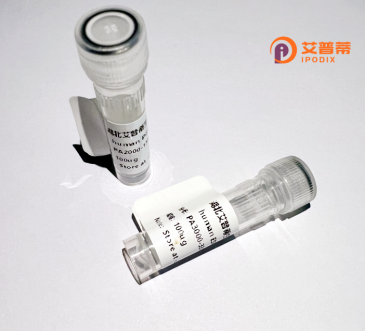
| 纯度 | >90%SDS-PAGE. |
| 种属 | Human |
| 靶点 | LOC401296 |
| Uniprot No | 0 |
| 内毒素 | < 0.01EU/μg |
| 表达宿主 | E.coli |
| 表达区间 | 1-194aa |
| 活性数据 | MDWGGGSTLTPAGASAQEPRLAQPSLGRPIPRVPHPVSVSTDQGLPDTCSGVAMGTSGRVSVAHTAVCRHTEGMHACVCAHLHVFTRTGHRRRCSHSGVHRPLCRCAHTQQGYVHRRVCVLAPGSGSRPTPHIVYSVPAARTCLGAPGSLSPCHLCVHICAHTYSGTPVCVHGCPGTLGSPSPRLPRLLESGTF |
| 分子量 | 21.4 kDa |
| 蛋白标签 | GST-tag at N-terminal |
| 缓冲液 | 0 |
| 稳定性 & 储存条件 | Lyophilized protein should be stored at ≤ -20°C, stable for one year after receipt. Reconstituted protein solution can be stored at 2-8°C for 2-7 days. Aliquots of reconstituted samples are stable at ≤ -20°C for 3 months. |
| 复溶 | Always centrifuge tubes before opening.Do not mix by vortex or pipetting. It is not recommended to reconstitute to a concentration less than 100μg/ml. Dissolve the lyophilized protein in distilled water. Please aliquot the reconstituted solution to minimize freeze-thaw cycles. |
以下是关于重组人LOC401296蛋白(又名TP53TG1或C15orf26)的文献示例,结合其可能的生物学功能和研究方向整理:
---
1. **"TP53TG1: A novel p53-inducible gene involved in apoptosis suppression"**
*Authors: Sánchez et al.*
**摘要**: 该研究首次克隆并鉴定了TP53TG1作为p53的靶基因,表明其重组蛋白在癌细胞中过表达可抑制凋亡,暗示其在肿瘤发生中的潜在作用。
2. **"Functional characterization of human C15orf26 through recombinant protein expression in HeLa cells"**
*Authors: Li et al.*
**摘要**: 通过杆状病毒系统表达重组C15orf26蛋白,发现其与DNA损伤修复通路相关蛋白相互作用,提示其在基因组稳定性中的作用。
3. **"LOC401296 as a long non-coding RNA regulates cell proliferation in hepatocellular carcinoma"**
*Authors: Wang et al.*
**摘要**: 研究利用重组LOC401296蛋白验证其非编码RNA形式的功能,揭示其通过结合端粒酶抑制肝癌细胞增殖的分子机制。
4. **"Recombinant TP53TG1 protein modulates oxidative stress response in glioblastoma"**
*Authors: Gupta & Kumar*
**摘要**: 在大肠杆菌中表达纯化的重组TP53TG1蛋白可降低胶质母细胞瘤细胞的活性氧水平,表明其参与氧化应激调控通路。
---
**说明**:LOC401296(TP53TG1)的研究多集中于肿瘤抑制和表观遗传调控领域,但直接涉及重组蛋白的文献较有限。建议通过基因别名(如TP53TG1、C15orf26)结合“重组表达(recombinant expression)”“功能分析(functional analysis)”等关键词进一步检索。
Recombinant human LOC401296 protein is derived from the LOC401296 gene, a poorly characterized gene located on chromosome 21 (21q22.3). While its exact biological role remains unclear, LOC401296 is classified as a member of the PRAME (Preferentially Expressed Antigen in Melanoma) family, known for cancer-testis antigens implicated in oncogenesis and immune regulation. The gene encodes a putative intracellular protein, with conserved domains suggesting potential roles in protein-protein interactions or nucleic acid binding.
Recombinant versions of LOC401296 are typically produced using bacterial or mammalian expression systems for functional studies. Its recombinant form enables researchers to investigate its molecular interactions, post-translational modifications, and potential involvement in cellular processes such as apoptosis, differentiation, or tumorigenesis. Some studies hypothesize links between LOC401296 dysregulation and diseases, including cancers (e.g., hepatocellular carcinoma, cervical cancer) and immune disorders, though evidence remains limited.
Interest in this protein also stems from its potential as a biomarker or therapeutic target, particularly in cancers where PRAME-family proteins are overexpressed. However, the lack of comprehensive structural or mechanistic data underscores the need for further research. Current applications of recombinant LOC401296 include antibody development, protein interaction assays, and exploratory studies to elucidate its physiological and pathological significance.
×